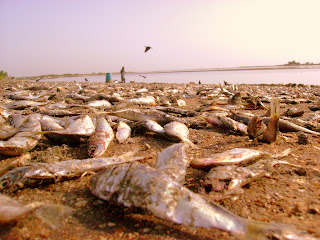 |
| Isolated beaches at Pulicat |
India’s second largest lake, Pulicat is home to a wide variety of marine and avian fauna. Some call it brackish water lagoon; some call it an estuary and some as backwaters. For the one who is stunned by the clarity of this place, all these terms are mere sounds.
Well, I got introduced to Pulicat through my college field visits. Every month we spend 3 days at our college’s wet lab station which is located adjacent to the lake. I spend my time performing various experiments, eating lip smacking food and not to mention of the pure sensation of just being there. Surely, it’s a paradise for a marine biologist. The most fun filled part of my trips, are the boat rides and island visits which are often isolated, devoid of human touch.
 |
| Fresh catch of Mullets |
The main occupation of people living in Pulicat, is fishing. There are many fishing hamlets and around 50 thousand traditional fisherfolk live in about 65 villages all around the lake. There are certain areas that are extremely affected due to pollution and there are certain areas still virgin. One of the highlights of Pulicat is the arrival of migratory birds during the nesting season and the most awaited winged visitor is none but the 6 foot tall, pink bodied Flamingos. Pulicat is fast evolving tourist location, where tourists pay a visit to see these birds every season. There are about 500 species of macrofauna (Sanjeeva Raj, 2006), which naturally signifies the rich value of Pulicat’s biodiversity. There are also 80 species of birds, mostly migrants feeding at the Pulicat bird sanctury.
A peculiar way of fishing is practiced at Pulicat known as Paddu system. This system is said to be caste based and it been claimed as an eco-friendly way of fishing. Irulas, who are scheduled tribe living at Pulicat, are prohibitted to use any fishing gears and hence they use methods like hand picking of shrimps.
 |
| A dead Olive Ridley at Pulicat |
According to my proffessor Dr. Deepak Samuel, Pulicat has changed a lot. He’s been visiting the lake since 1993, when he was a college student. “Siltation in the lake has increased drastically and the sea grass beds have declined massively. When I was a student, people used to fish in the estuary for shrimps and other fishes, but now they venture into the sea for fishing. The catches in the estuary have gone down and only crab fishery happens here” he says. The average depth of the lake was 3.8 metres and now it is not more than 1 metre. This is due to the severe degradation of the watershed area of the river outlets and monsoon floods discharge massive amount of silt in the lake. During the Dutch era, their ships were anchored inside the lake right against the town of Pulicat, but now it seems like a dream.
 |
| Fishes at Pulicat market |
The greatest threat to Pulicat lake is the thermal and slurry pollution from North Chennai Thermal Power Station (NCTPS) from Ennore in the south (Sanjeeva Raj 2000). Overfishing to meet export demands is also another major problem. Using destructive fishing gears, restlessly fishing day and night have increased the fishing pressure in this region.
 | |||||
| A temple built by King Krishnadevaraya |
Pulicat has a lot of historical value too. The Cholas built temples here and in the 13th century muslims from Mecca arrived. It was followed by Portugese in 16th, the Dutch in the 17th and by the British from 18th century onwards. Pulicat still boasts the glorious and the ancient past through its temples, churches and cemeteries.
According to me, Pulicat lake is mixture of past and the present. One feels like walking through the history in this town. The future of Pulicat looks very bleak until and unless radical measure are undertaken to conserve this enigmatic lake.
Photos © Rahul Muralidharan
Some glimpses
References
- Pulicat lake status and future conservation strategies (P.J.Sanjeeva Raj, J. Logamanya Tilak, V.Deepak Samuel)






dear rahul
ReplyDeletei hate to say it. but if you continue this kind of blogging, you will be documenting the death of a beautiful, productive wetland. and i wish you would not only document it, but also be part of the fight against its degradation.
ciao, nity
I get you Nity. I'll give my best to protect this lake.
ReplyDeleteHi rahul,
ReplyDeleteDont focus only southern pulicat lake, try to focus northern part also, bcoz what ur focusing is just 25% of the lake only.. so dont judge with these documents...All the best for your effort trowards our mother land....
I'm not sure, but I think I heard first about Pulicat only after coming here. And only now I got to know about it. I wonder, I've never located this in any of my geography books too. In fact, it's a good thing that much of it is not revealed through books and other media so that it could remain devoid of indiscriminate ways of human touch. I wish I could visit the place...the only difficulty being our inability to co-ordinate and spare enough time for the travel. But I will always be able to support your efforts for the conservation of Pulicat's encroached regions and the preservation of its untouched areas.
ReplyDelete